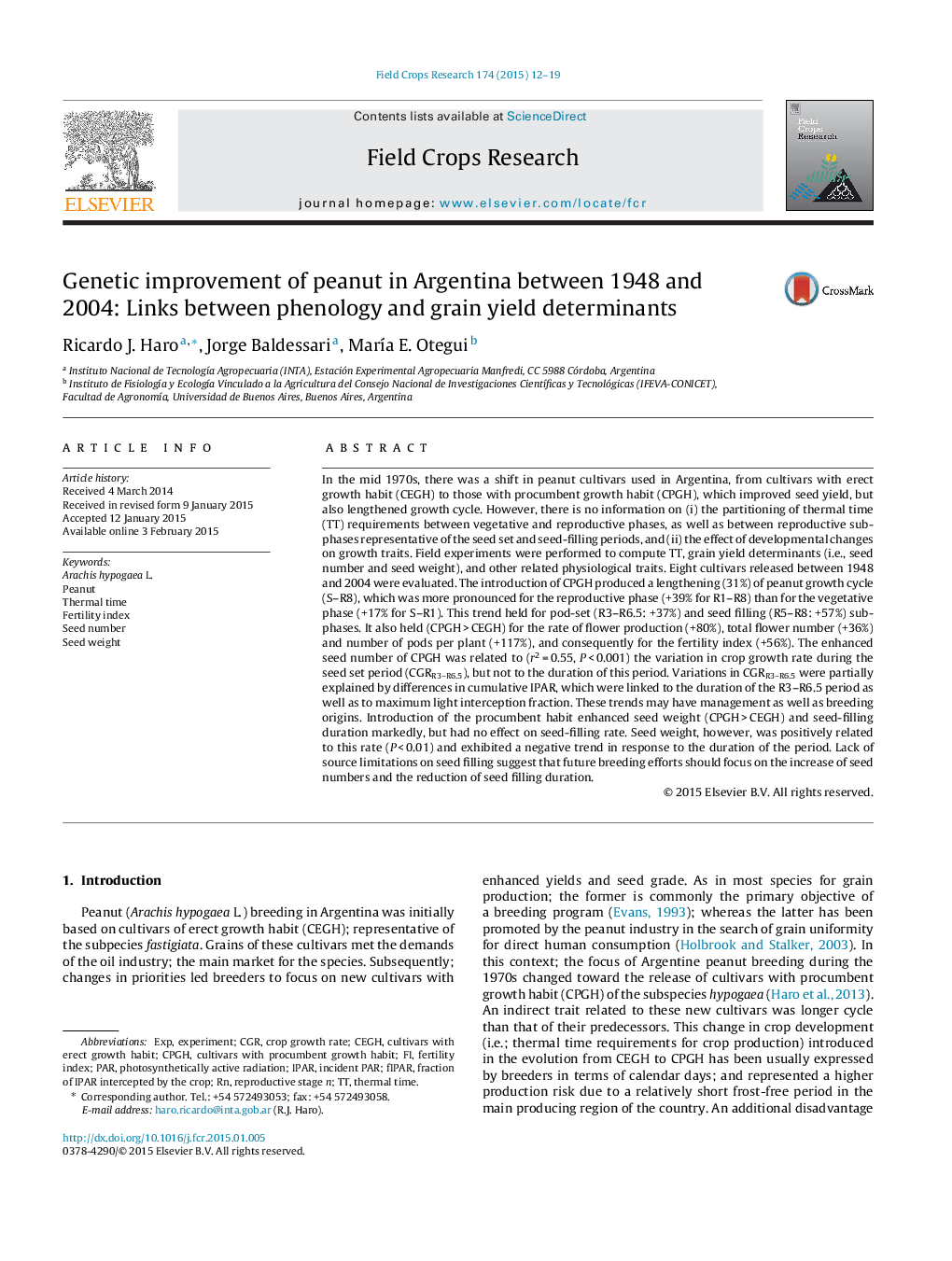| کد مقاله | کد نشریه | سال انتشار | مقاله انگلیسی | نسخه تمام متن |
|---|---|---|---|---|
| 4509917 | 1624689 | 2015 | 8 صفحه PDF | دانلود رایگان |
عنوان انگلیسی مقاله ISI
Genetic improvement of peanut in Argentina between 1948 and 2004: Links between phenology and grain yield determinants
ترجمه فارسی عنوان
بهبود ژنتیکی بادام زمینی در آرژانتین بین سال های 1948 و 2004: ارتباط بین فنولوژی و تعیین کننده های عملکرد دانه
دانلود مقاله + سفارش ترجمه
دانلود مقاله ISI انگلیسی
رایگان برای ایرانیان
کلمات کلیدی
CgrEXPFiparArachis hypogaea L.Experiment - آزمایش یا تجربهPeanut - بادام زمینی، پستهشامیPhotosynthetically active radiation - تابش فعال فتوسنتزیSeed number - تعداد دانهPar - توسطThermal time - زمان حرارتیCrop growth rate - سرعت رشد محصولfertility index - شاخص باروریIPAR - صنعتSeed weight - وزن دانه
موضوعات مرتبط
علوم زیستی و بیوفناوری
علوم کشاورزی و بیولوژیک
علوم زراعت و اصلاح نباتات
چکیده انگلیسی
In the mid 1970s, there was a shift in peanut cultivars used in Argentina, from cultivars with erect growth habit (CEGH) to those with procumbent growth habit (CPGH), which improved seed yield, but also lengthened growth cycle. However, there is no information on (i) the partitioning of thermal time (TT) requirements between vegetative and reproductive phases, as well as between reproductive sub-phases representative of the seed set and seed-filling periods, and (ii) the effect of developmental changes on growth traits. Field experiments were performed to compute TT, grain yield determinants (i.e., seed number and seed weight), and other related physiological traits. Eight cultivars released between 1948 and 2004 were evaluated. The introduction of CPGH produced a lengthening (31%) of peanut growth cycle (S-R8), which was more pronounced for the reproductive phase (+39% for R1-R8) than for the vegetative phase (+17% for S-R1). This trend held for pod-set (R3-R6.5: +37%) and seed filling (R5-R8: +57%) sub-phases. It also held (CPGHÂ >Â CEGH) for the rate of flower production (+80%), total flower number (+36%) and number of pods per plant (+117%), and consequently for the fertility index (+56%). The enhanced seed number of CPGH was related to (r2Â =Â 0.55, PÂ <Â 0.001) the variation in crop growth rate during the seed set period (CGRR3-R6.5), but not to the duration of this period. Variations in CGRR3-R6.5 were partially explained by differences in cumulative IPAR, which were linked to the duration of the R3-R6.5 period as well as to maximum light interception fraction. These trends may have management as well as breeding origins. Introduction of the procumbent habit enhanced seed weight (CPGHÂ >Â CEGH) and seed-filling duration markedly, but had no effect on seed-filling rate. Seed weight, however, was positively related to this rate (PÂ <Â 0.01) and exhibited a negative trend in response to the duration of the period. Lack of source limitations on seed filling suggest that future breeding efforts should focus on the increase of seed numbers and the reduction of seed filling duration.
ناشر
Database: Elsevier - ScienceDirect (ساینس دایرکت)
Journal: Field Crops Research - Volume 174, 15 March 2015, Pages 12-19
Journal: Field Crops Research - Volume 174, 15 March 2015, Pages 12-19
نویسندگان
Ricardo J. Haro, Jorge Baldessari, MarÃa E. Otegui,
